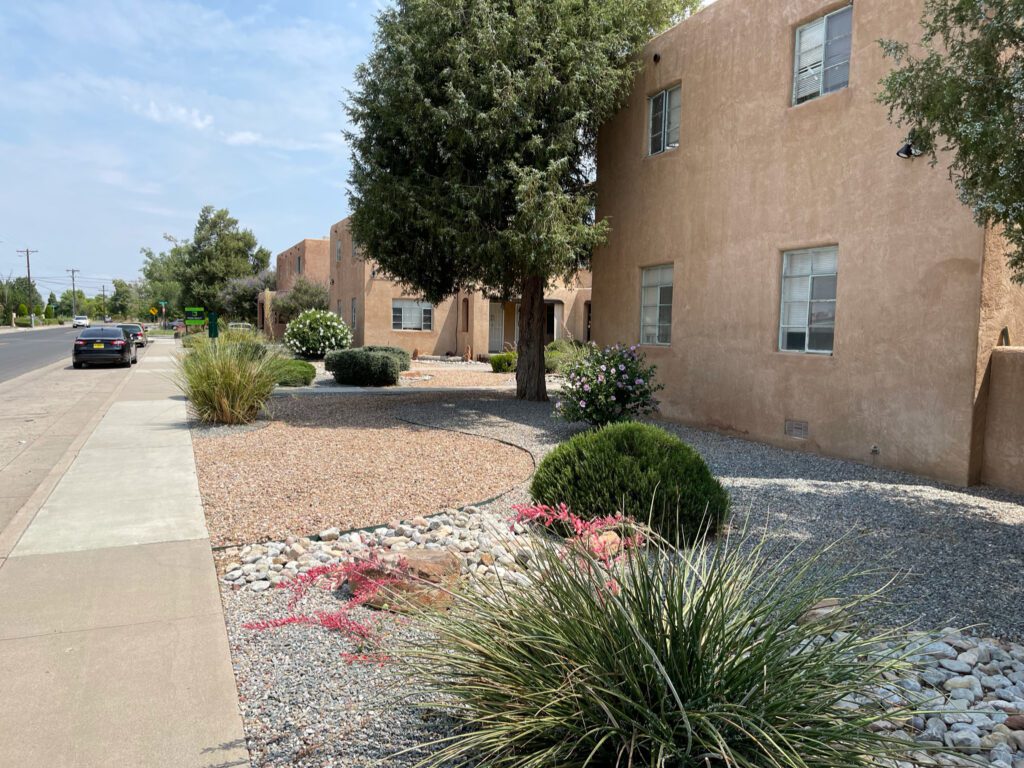What are the Basic Principles of Xeriscaping?

Xeriscaping challenges gardeners to make peace with nature, rather than try to dominate it, by choosing plants and design elements that flourish under local conditions and need relatively little water.
The adoption of these basic principles begins the naturally landscape where water preservation is important in 2 considerations of design, irrigation, plant material among others.
Xeriscaping, which requires less water and maintenance, takes the guesswork out of gardening when it comes to maintaining a healthy environment.
Plan your design
The planning is there so that at the end of the day, once you’ve put in some time and effort, you can take a seat and appreciate what you’ve done and so you’re not going back and fixing mistakes.
First, you need a plan, first of all. And I’m not just referring to sketching out where you’d like your plants to go, though that’s coming up. Successful xeriscaping begins by getting to know your site.
The big idea is to find the right plants for the right place, rather than to force the landscape to suit the plants you wish you could grow.
To get started, you should be able to answer these questions:
- What is your soil like?
- What is the sun like where you want to plant?
- What is the pattern of water flow on your property?
- Do you have any semi-tropical environments you could ride through?
- As always: “Good planning makes for good gardens.”
If you gloss over this step, you’re asking for frustration later. And hey, if planning feels like a drag, just keep in mind that you’ll be saving yourself a lot of headaches later on.
Improve your soil
Here’s where things get interesting. Many experts advise always adding organic matter — compost, for example — to your soil before planting.
But it’s not so clear-cut sometimes.
When it comes to xeriscaping, less can be more. In fact, over-amend with organic matter can waste more than help. Cabbages may like rich, moist soils, but cabbaging plants like something that feels more like home, and in most cases that is arid.
Most xeriscape soils need only 3-5% organic matter. IF YOU’RE already in that name range, put the compost down and back away slowly. The best thing you can do for your soil is sometimes to do nothing at all.
And you can hurt your soil by overworking it. And lift it Loosen and lift the soil if it’s compacted, but don’t add more material than you can afford to move. Instead, select the proper plants and let them act as soil builders over time.
Inorganic Changes and Improving Drainage
And as far as mixing gravel or sand in with your soil to “improve drainage,” be wary.
Such recommendations frequently originate in wetter places, where damper climates can lead to garden envy at the sight of our lush selection of drought-tolerant plants.
If you’ve got soil that’s not draining correctly in Albuquerque, there’s a good chance that you’ve got lakefront property, a plumbing leak, or you’re watering excessively.
The usual challenge for plants here is not too much water, but not enough.
In addition, incorporating rocks may not be good for drainage anyway. Unless you were adding a majority of it, like when you were adding 60% of the volume of it, it’s not giving you the intended effect. In fact, it might even make things worse by leading water to run off instead of soaking in.
So unless you are for solving a very specific problem or doing some specialty gardeningyou should pass right over gravel and sand.
The answer is to give up trying to change your soil to suit particular plants, and to select plants that will appreciate your soil.
Nearly 400,000 species of plants are known to exist on earth — 3,000 of them are native to New Mexico — and let me tell you, there’s an answer out there for any situation.
Irrigate efficiently
Sprinklers in a grass lawn
“Use efficient irrigation.” Seems obvious, right?
But we should really reflect on what that concept means.
Drip irrigation is frequently quoted as the ideal solution for xeriscaping, and although it is indeed a wonderful way to prevent evaporation, it’s not the only game in town. The answer is to revisit your run times and frequency.
Xeriscaping is all about coaxing plants to develop deep, resilient root systems. Ensure the drip system is running infrequently but for a long time to soak the soil and encourage extensive root growth.
Strong plants depend on a strong root system. If plants are accustomed to getting some water every day, they will not be tough enough to stretch their roots to seek water during hard times.
The water use of your xeriscape should be minimal. Consider your irrigation system Plan B, not Plan A.
If you are watering, do so deeply and infrequently. The idea there is to train your plants to search farther into the soil for their water, which over time can make them more drought tolerant.
If you are not sure whether you need an irrigation system, maybe you don’t: An irrigation system is not always necessary. Most of the xeric plants, once established, grow on natural precipitation only.
BONUS: If you find yourself needing to casual hand water is a delightful way to spend quiet time outside and also give you the opportunity to say “Hi,” to nosey neighbors you haven’t been introduced to who are sure to be asking you questions galore about your lush landscape.
Use Drought Tolerant Plants
It’s not xeriscaping without drought-tolerant plants, now, is it? But here’s the thing: don’t get overly hung up on the native-or-not issue.
Sure, native can be good but even more important is whether the plant is adapted to your site.
If you’re talking native plants, it’s asked, “Native to where?” Flowers that thrive in mountain soil may not have the talent to perform in your sun-soaked front yard. The secret is selecting plants that are a perfect fit for your soil, sun exposure and climate.
Remember, drought-tolerant doesn’t mean dull. There are many colorful, lovely plants that will do well in a xeriscape garden without being water-guzzlers.
Limit Turfgrass
Two men pulling grass out of a front yard
Turf can be excellent for soccer fields, but it might not be the best for your front lawn. Turf reduction or elimination is one of the surest ways to reduce water consumption.
That said, though, don’t just rip out the grass and leave a barren wasteland. Replace a lawn with drought-tolerant perennials, xeric grasses (like buffalo or blue grama), remembering to reprogram the irrigation clock.
If artificial turf has crossed your mind, well, we didn’t say anything, but there are definitely other choices. Artificial turf becomes scorching, needs to be watered to cool (just like dogs), is cleaned with water, and winds up in a landfill. Not a particularly sustainable option you want to go for.
Utilize Mulch
This is a completed front yard xeriscape landscape
Mulch can be all sorts of things, from wood chips to pea gravel.
Both organic and inorganic mulch are your friend. Mulch is meant to reduce evaporation, inhibit the germination of weed seeds, and protect plant roots from temperature extremes.
But, all mulches are not made equal.
Wood mulches, for instance, work particularly well in shady areas, beneath shrubs and around trees. But it can becoem hydrophobic and spit water when subjected long enough to lots of sun, as it does in a dry climate such as New Mexico. If you take this route, just be sure to disturb the mulch regularly so that it does not form a water-repelling crust.
Gravel mulch is an alternative to wood mulch that’s perfect for xeriscaping. It lets water seep in but blocks evaporation to help keep your soil moist.
And gravel mulch does not break down, so you’ll never have to replace it. If you’re dealing with weeds, make sure it’s thick enough to perform its function; a depth of about four inches should suffice. But, even a thinner layer will encourage natural rainfall infiltration.
Maintain Your Landscape
The good news is keeping up a xeriscape garden isn’t all that different from keeping up a regular yard. You will not have a different life, but your tasks will change. Instead of mowing weekly, you will be cutting back perennials after a year, but even then, you can use a lawn mower.
You could be deadheading spent penstemon flowers or pulling a few drought-tolerant weeds rather than tweaking your sprinkler heads.
But one thing hasn’t changed: if you provide your plants what they require, they will grow. And in a xeriscape, they’ll frequently do so with a whole lot less of your intervention.
Monitor your irrigation as your garden grows. The objective is to program less watering over time, ultimately allowing your xeric plants to be maintained by rain alone. And don’t forget, while a xeriscape doesn’t require zero care, it requires almost zero care. Paired with regular check-ins and seasonal adjustments, they are the essence of having a garden that always looks its best.
The Bottom Line
Xeriscaping is all about being wise in the use of resources, selecting plants adapted to your environment, watering efficiently, and making the most of moisture retained in the soil with mulch. It is a method for growing a beautiful, abundant garden that doesn’t empty your wallet, your time or the local water table.
Keep in mind that, xeriscaping doesn’t have to result in making your garden look like a desert (unless that’s what you’re going for). It’s really figuring out how to strike that balance between beauty, sustainability and pragmatism. So, step back, plan a little and get ready to enjoy a low-runoff, water-wise garden that makes you proud.
Now, go forth and xeriscape! Your garden — and your water bill — will thank you, too.
